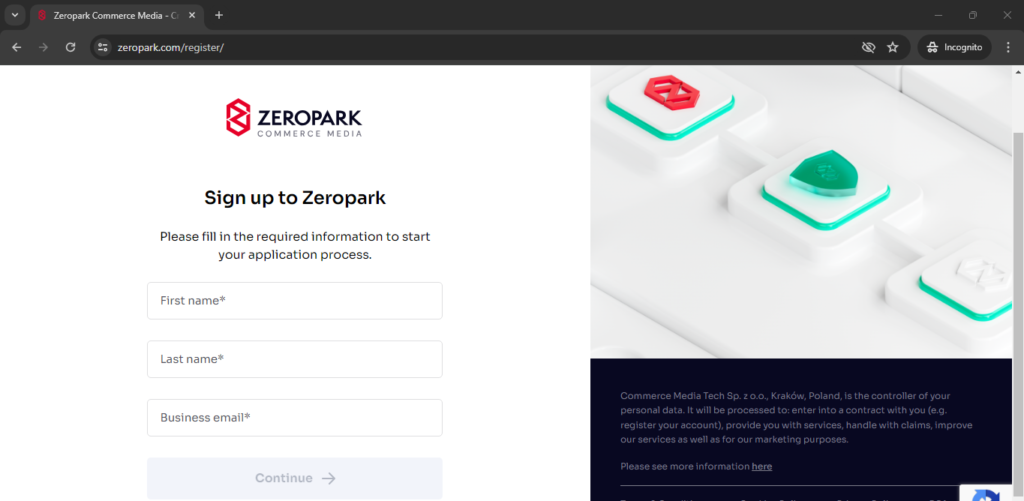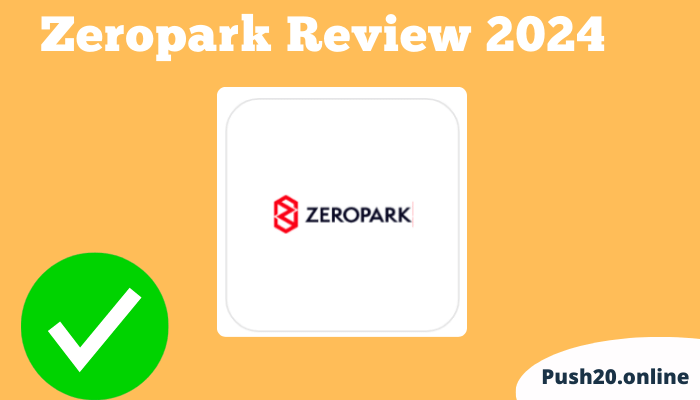To succeed in affiliate marketing, it’s essential to stay equipped with the most effective platforms. This Zeropark review explores its key features, so you can make an informed decision about your campaigns. Affiliates and advertisers worldwide trust Zeropark for its intuitive interface, precise targeting, and wide range of ad formats. To help you elevate your affiliate marketing strategies in 2024, this analysis analyzes whether Zeropark is the best tool for digital marketing.
What is Zeropark?
Zeropark is a real-time bidding (RTB) advertising platform specializing in domain, pop, and push traffic. It’s not just a marketplace for buying and selling traffic but a bridge that connects advertisers with publishers. Its unique selling point lies in its ability to facilitate the acquisition of high-quality traffic for various advertising campaigns, making it an invaluable tool for marketers aiming to boost their online presence and achieve their conversion goals.
Why Choose Zeropark?
Opting for Zeropark as your advertising platform brings with it a host of benefits. Its extensive traffic network and advanced targeting options allow for precise audience targeting, while its real-time bidding system ensures cost efficiency. What’s more, the platform’s user-friendly interface and robust support system make campaign management a breeze. Whether you’re a seasoned marketer or a newbie, Zeropark provides you with the tools and resources you need.
How to Set Up an Account with Zeropark
Getting started with Zeropark is as simple as creating an account.
Step 1: Visit the Zeropark Website
Start by navigating to the Zeropark website. Here, you’ll find comprehensive information about the platform’s features, pricing, and the types of traffic available. Familiarize yourself with the site to ensure Zeropark aligns with your advertising needs.

Step 2: Sign Up
On the homepage, look for the “Sign Up” button. This will take you to registration. Please enter your name, email address, and password. Ensure the information is accurate, which will be crucial for account verification and communication.
Step 3: Account Verification
After submitting your registration form, Zeropark will send a verification email to your provided address. Check your inbox (and spam folder, just in case) for an email from Zeropark. Follow the instructions to verify your account. This step is vital for security purposes and to prevent fraudulent activities.
Step 4: Funding Your Account
Once your account is verified, the next step involves funding your account. Zeropark offers various payment methods, including credit cards, PayPal, and wire transfers. Choose the most convenient option and follow the prompts to add funds to your account. Note that there might be a minimum deposit requirement, depending on the payment method selected.
Step 5: Setting Up Your First Campaign
With your account set up and funded, you’re ready to launch your first advertising campaign on Zeropark. Navigate to the “Campaigns” section and select “New Campaign.” Here, you’ll be guided through setting up your campaign, including choosing the type of traffic, setting your budget, targeting options, and creating your ad creatives.
Step 6: Monitoring and Optimization
Once your campaign is live, it’s vital to monitor its performance closely. Zeropark offers extensive analytics and reporting features, giving you real-time insights into campaign effectiveness. Leverage this data to make informed adjustments and improve your campaign’s ROI.
Creating a Campaign on Zeropark
You are now ready to launch your first campaign after setting up your account.
Step 1: Account Setup
The first step to launching a campaign on Zeropark is setting up an account. Visit the Zeropark website and sign up by providing the necessary details. Once your account is verified, familiarize yourself with the dashboard. This is where you’ll manage your campaigns, track performance, and adjust optimization settings.
Step 2: Campaign Creation
Click the “New Campaign” button from your dashboard to create a new campaign. Zeropark will guide you through several steps, each crucial for the success of your campaign.
- Campaign Type
Select the type of campaign you want to run: Pop, Domain, or Push. Each has its advantages, depending on your advertising goals and the nature of your offer.
- Targeting Options
Here, you’ll define who sees your ads. Targeting can be based on geographical location, device type, operating system, etc. Your ads will reach the most relevant audience, increasing conversion rates.
- Budget and Bidding
Set your campaign budget and bid. Zeropark operates on a cost-per-view (CPV) model for Pop and Domain campaigns and a cost-per-click (CPC) model for Push campaigns. Your bid reflects how much you’re willing to pay per view or click, influencing your ad’s visibility among competitors.
Step 3: Ad Creatives and Landing Pages
Craft compelling ad creatives and design engaging landing pages. Your ad creative should be attention-grabbing and relevant to your target audience, while your landing page should provide value and encourage visitors to take action. Ensure your notification title and message are clear and concise for Push campaigns.
Step 4: Tracking and Optimization
Successful campaigns demand data-driven decisions. Zeropark seamlessly integrates with top tracking solutions, giving you the power to monitor conversions, pinpoint high-performing segments, and strategically refine your campaign. Make data analysis a habit for optimal results.
Step 5: Launch and Monitor
Once your campaign setup is complete, initiate launch. Carefully monitor early performance using Zeropark’s real-time analytics. Make necessary adjustments to enhance results. Pay special attention to conversion rates, ROI, and cost per acquisition (CPA) for optimal campaign performance.
Best Practices for Zeropark Campaigns
- Test Extensively: Run small tests to identify high-performing targeting options and scale them gradually.
- Creative Rotation: Regularly update your ad creatives and landing pages to maintain user engagement.
- Utilize Automation: Use Zeropark’s automation features to optimize bids and pause underperforming sources.
- Stay Informed: Keep up with Zeropark’s updates and best practices to leverage new features or insights.
Ad Formats at Zeropark
Zeropark offers a variety of ad formats that cater to advertisers’ individual needs and preferences. By offering a variety of formats, you can choose the one that best suits your campaign objectives.
1. Pop Ads:
- What they are: Pop ads are the most well-known ad format and appear as new browser windows or tabs in front of or behind the user’s currently viewed page.
- Pros: High visibility, potential for strong engagement, ideal for generating leads and quick conversions.
- Cons: Can be seen as intrusive if not used strategically.
- Best for: Offers that require immediate attention, time-sensitive promotions, lead generation.
2. Domain Redirect Ads:
- What they are: When a user clicks on a domain, they are in Offers that require immediate attention and time-sensitive promotions and instead get redirected to your landing page or offer.
- Pros: Less intrusive than pop ads, suitable for branding, and generating awareness.
- Cons: Lower click-through rates than pop ads.
- Best for branding campaigns and content promotion and offers relevant to the domain’s usual content.
3. Commerce Media Ads:
- What they are: Commerce Media provides high-quality, non-intrusive, and brand-safe placements for your ads. These ads are designed to match customers with brands seamlessly using sophisticated targeting.
- Pros: Excellent for brand building, accessing premium traffic, and reaching audiences interested in specific products or services.
- Cons: Availability requires prior approval and can be more expensive than other formats.
- Best for brand-conscious advertisers, reaching targeted product-oriented audiences and accessing high-value traffic.
4. Deeplink Ads:
- What they are: Deeplink ads allow you to match your offers to relevant audience searches using broad contextual keywords.
- Pros: Taps into specific user interests, highly targeted, increases chances of conversion.
- Cons: Requires strategic keyword selection to be effective.
- Best for: Targeted product or service promotion, reaching engaged searchers ready to take action.
Pros and Cons of Using Zeropark
Like any other advertising platform, Zeropark has its strengths and weaknesses.
Pros
- Robust targeting options that enable highly targeted campaigns.
- Advanced analytics tools that give detailed insights into campaign performance.
- A vast traffic inventory that can support a variety of ad formats.
- Strong anti-fraud measures to ensure the quality of traffic.
- Excellent customer support and knowledge base for advertisers.
Cons
- The learning curve may be steep for beginners to understand and utilize all the available features.
- The minimum deposit amount can be relatively high for some advertisers.
- The platform is focused on performance marketing, so it may not be suitable for all types of advertisers and campaigns.
Pricing Plans for Zeropark
Budgeting and cost estimation depend on understanding Zeropark’s pricing structure.
- Starter Plan: Ideal for beginners or those with a limited budget, this plan provides the core functionalities needed to launch essential ad campaigns.
- Professional Plan: Tailored for advertisers seeking more control and optimization options, this plan offers advanced features like A/B testing and campaign scheduling.
- Enterprise Plan: Designed for high-volume advertisers, this plan boasts premium features, priority support, and potentially the most competitive CPM rates.
Pricing Models for Zeropark
Zeropark primarily operates on a Cost-Per-Click (CPC) model. Advertisers only pay when users click on their ads. You can use this model to generate leads or sales by driving targeted traffic to your website.
Here’s a breakdown of other pricing models you might encounter on Zeropark:
- Cost Per Mille (CPM): Advertisers pay a fixed fee for every 1,000 impressions (ad views) their ad receives, regardless of clicks. This model suits brand awareness campaigns where impressions are the primary goal.
- Cost Per Action (CPA): An advertiser only pays when an action is completed, such as a signup or purchase. You only pay for conversions in this model, which ensures a high return on investment (ROI).
- Revenue Share: In rare cases, advertisers might agree to a revenue share model, where they share and is a percentage of their generated revenue with Zeropark. This model is often used when the advertiser’s success is directly tied to Zeropark’s traffic quality.
Choosing the Right Model:
The optimal pricing model hinges on your advertising objectives. Here’s a quick guide:
- For brand awareness and website traffic, Opt for CPC or CPM. CPC offers better control over costs, while CPM can maximize impressions.
- For lead generation and signups: Leverage CPA to ensure you only pay for valuable actions.
- For promoting high-value products or services: Consider CPA to guarantee conversions and a positive ROI.
Conclusion
With Zeropark, affiliate marketers can create, target, and optimize campaigns To promote high-value products or services, considerto increase c onversions. Zeropark’s analytics provide advertisers with detailed insights into their campaigns, enabling them to make data-driven decisions.
Carefully consider your campaign goals, budget, and level of advertising experience before signing up with Zeropark. If you’re a seasoned advertiser looking for a platform that empowers precise targeting and real-time optimization, Zeropark could be your secret weapon for success in 2024. and beyond.
